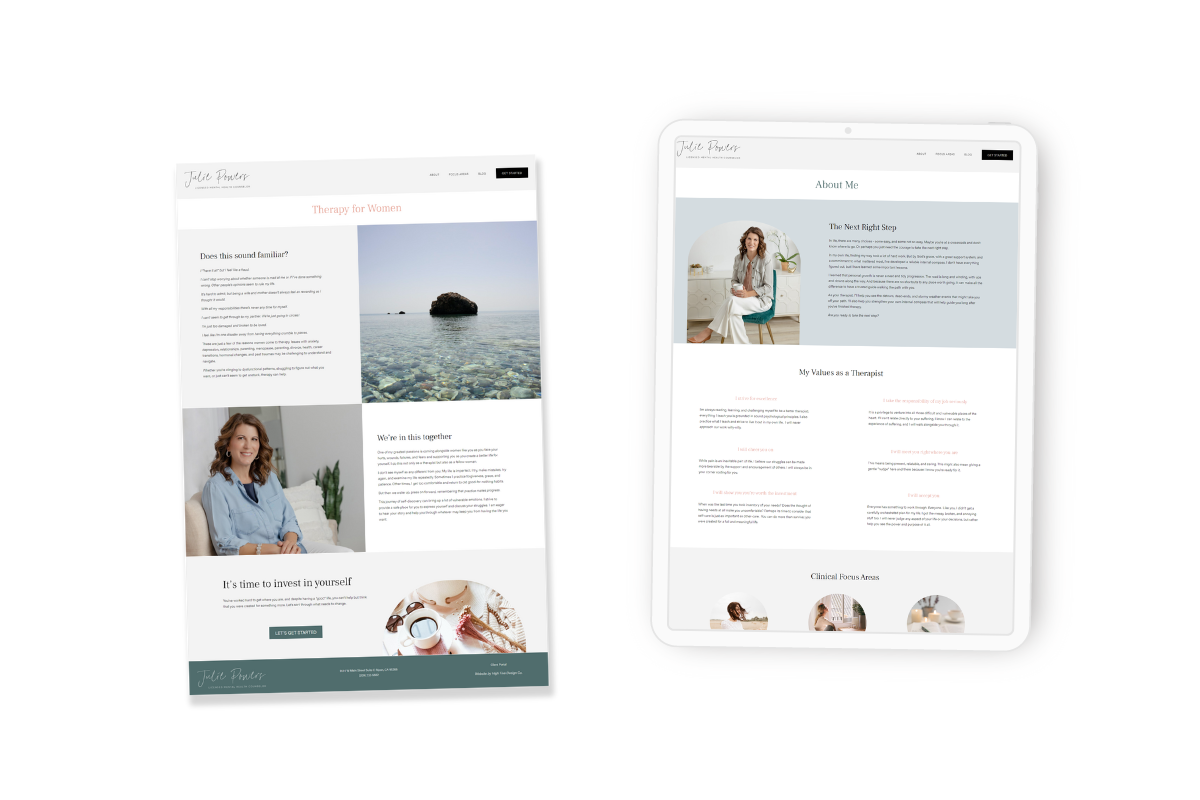Blogging SEO: The Therapist's Easy Guide to Boosting Blog Visibility
We're diving headfirst into the world of SEO – that's Search Engine Optimization for those still deciphering the alphabet soup. I come bearing good news: Despite its mystique, SEO is actually pretty painless! Think of SEO as the map that guides you through the maze of search engine algorithms, leading you straight to high rankings.
Today, we're focusing on optimizing your blog posts – the jewels in your content crown. I know what you're thinking: "But where do I start? What do I do?" I've crafted a delightful checklist of SEO tasks for you. And to make it even easier, I've sorted the tasks by importance so you can focus on the ones that pack the mightiest punch. So, grab your laptop and a cup of coffee, and let’s do this!
Super Important
Keyword Treasure Hunt
Pretend you're a detective on a mission to find the perfect words your ideal clients are typing into Google. These are your keywords! Think about what they might search for when looking for a therapist like you. Brainstorm some ideas, use tools like Google Keyword Planner, and uncover those hidden gems.
Be sure to also to target long-tail keywords specific to your niche. What’s a long-tail keyword? Imagine searching for a specific type of therapist in a big city. You could start with a broad search like "New York therapist," but that might bring up a huge list of options. Now, imagine I refine my search to something more specific, like "EMDR Therapist who treats women with body image issues in Brooklyn." That's a long-tail keyword – it's longer and more detailed, helping you find exactly what you're looking for amidst the sea of options. In SEO, long-tail keywords are like laser-guided missiles, honing in on a specific audience and increasing the chances of your content being found by those truly interested in what you offer.
The Headline Hero
Your headline is like the superhero of your blog post. It's the first thing people see, so make it catchy and informative. Think of it as the trailer to a blockbuster movie – it should grab attention and leave them wanting more. Don't forget to sprinkle in those juicy keywords for an extra punch!
Fun tip: Use AI (ChatGPT is my fave) to write headlines for your blog posts! To craft a clear, concise prompt that provides enough context for the AI to generate relevant suggestions, use key phrases related to the topic of your blog post, specify the desired intent or tone of the headline (i.e., informative, engaging, humorous) and tell it who your target audience is. You can also indicate your preference for headline length. By incorporating these elements into your AI prompt, you can maximize the chances of receiving headline suggestions that resonate with your target audience.
Meta Magic
Imagine the meta description as your blog post's dating profile. It's a short and sweet summary that tells search engines (and potential readers) what your post is all about. Be charming, be persuasive, and don't forget to include those keywords to attract the right matches!
In most website platforms, including Squarespace, you would typically find the option to edit meta descriptions within the settings or options for each individual blog post.
Content Goldmine
Your blog post content is like a treasure chest waiting to be discovered. Fill it with valuable information, helpful tips, and engaging stories that resonate with your readers. Remember, quality over quantity! Google loves content that's well-written, informative, and genuinely helpful.
If you are a slow or unconfident writer, you can leverage AI to help you produce more high-quality blog articles. To master the perfect prompt, provide clear direction to the AI writer, outlining the topic, target audience, tone, and content expectations for the blog post. Here’s an example:
Write a blog post aimed at empowering women with ADHD to embrace their neurodiversity and live boldly. Include practical tips, personal anecdotes, and insights from research or experts. The tone should be encouraging and supportive, and the content should offer actionable advice for readers to apply in their daily lives. The target audience is women with ADHD seeking empowerment and validation in their experiences.
Link Love
Internal linking is like building a web of connections within your website. It helps search engines navigate and index your content more easily while also guiding readers to other relevant pages. Think of it as a secret tunnel system that leads to more hidden treasures on your site!
Here are three examples of how a therapist might include internal links on their blog posts on their private practice website:
Related Blog Posts: Within a blog post discussing coping strategies for anxiety, you could include internal links to related blog posts on topics such as mindfulness techniques, stress management tips, or breathing exercises.
Service Pages: In a blog post addressing the challenges of communication in relationships, you could include internal links to specific service pages on your website that offer couples counseling or communication skills workshops.
About Page: In a blog post discussing your approach to treating depression, you could include an internal link to your About page. Perhaps allows readers to learn more about your background, qualifications, and therapeutic approach.
External Excursions
External linking is like giving your blog post a VIP pass to other reputable websites. You're adding credibility and context to your content by linking to trustworthy sources. It's like name-dropping a famous celebrity at a party – instant credibility boost! Here are some options:
Local Community Organizations
Educational Institutions
Local Media Outlets
Directories like PsychologyToday
Professional Associations or Organizations (e.g., American Psychological Association)
Mental Health Blogs or Websites (e.g., PsychCentral)
Nonprofit Organizations Focused on Specific Mental Health Conditions (e.g., Anxiety and Depression Association of America)
Podcasts or Online Mental Health Platforms (e.g., TED Talks on psychology topics)
Online Forums or Support Groups for Mental Health (e.g., Reddit communities)
Health and Wellness Websites or Blogs (e.g., MindBodyGreen)
Mobile Magic
In today's world, everyone's glued to their phones. So, make sure your blog posts look as good on mobile screens as on a desktop or laptop.
Schema Secrets
Schema markup makes it stand out and look extra tasty to search engines. By adding schema markup, you're giving search engines more information about your content, which can help improve your visibility in search results.
Full disclosure: I'm not yet a schema markup expert, but I’m committed to learning it, so stay tuned for a future blog post where I delve deeper into how therapists can harness the power of schema markup to supercharge their website's SEO performance and maximize their online presence.
Kinda Important
Picture Perfect
Images are super important in a blog post – they grab attention and make your content more visually appealing. But don't forget to optimize them with descriptive filenames and alt text. It's like giving each picture its own name tag at a party – it helps search engines understand what they're all about!
URL Roadmap
Your blog post URL is the address to your blog post. If the address isn’t clear, Google won’t know where to send potential readers. Keep the URL to your blog posts short, sweet, and packed with keywords to help search engines find and rank your content.
Social Butterfly
Think of social sharing buttons like invitations for your blog post. Adding them encourages your readers to spread the word and share your content with their friends and followers on social media.
Content Touch-Ups
Just like a fine wine, your blog posts get better with age. Give them a little makeover every now and then by updating outdated information, adding new insights, or even repurposing them into fresh formats like videos or infographics. It's like giving your old blog posts a facelift – they'll thank you for it!
Not-so-Important
Promotion Parade
While it's nice to shout from the rooftops about your awesome blog posts, don't stress too much about external promotion. Focus on creating valuable content that people naturally want to share, and the rest will follow. Let your blog posts speak for themselves – they've got plenty to say!
Performance Checkup
Monitoring your blog post's performance is like checking in on a plant to see how it's growing. Keep an eye on metrics like traffic, engagement, and keyword rankings to see what's working and what could use a little TLC.
Sitemap Submission
Submitting your sitemap to search engines is like sending out a party invitation – it's nice to do, but not essential for having a good time. Search engines are pretty smart these days and can usually find your content on their own. So, don't stress too much about this one!
Page Speed Perk-up
Speeding up your page loading time can give your website a turbo boost. While having a fast-loading site is nice, don't sweat it too much if it's not lightning-fast. You're good to go as long as your website is reasonably speedy.
SSL Security Shield
An SSL certificate adds extra protection and makes visitors feel safe. While it's a nice-to-have, it's not a deal-breaker for search engine rankings. So, don't worry too much if you haven't got one yet. It's like locking the door at night – it's good practice but not essential if you live in a safe neighborhood.
Congratulations, you've now got your hands on the ultimate SEO checklist, sprinkled with a bit of fun (and a lot of metaphors)!
SEO might seem daunting initially, but just like learning to walk, it's all about taking those first steps. Take your time moving through this checklist – there's no need to rush. And while the journey may have its challenges, remember that a website with no SEO work is only half-done. Prioritizing SEO isn't just about ranking higher on search engines; it's about maximizing the potential of your website and reaching your target audience. So, embrace the learning curve, keep your creativity flowing, and conquer those search engine rankings like the SEO superstar you are!

































